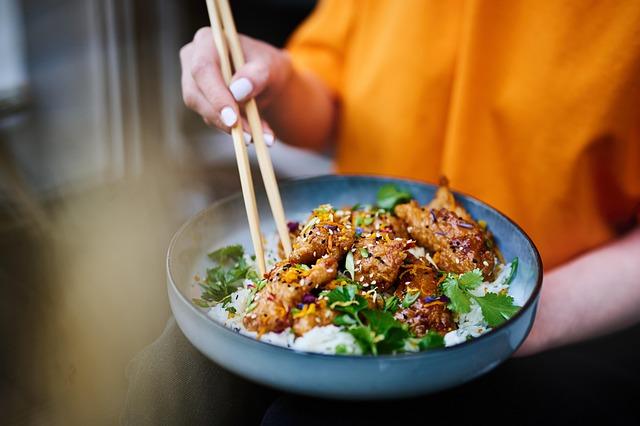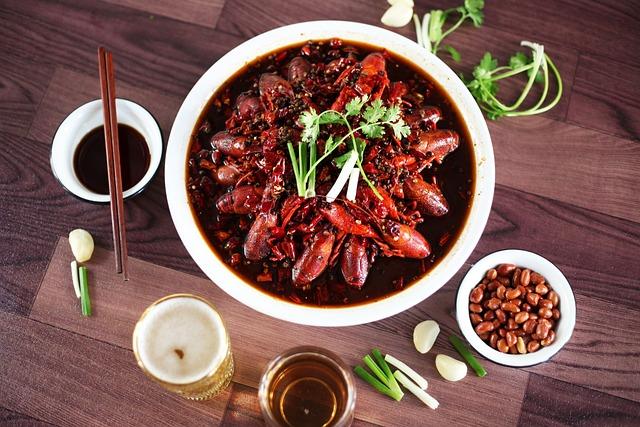In recent years,the culinary landscape of the United States has experienced a vibrant transformation,with Southeast Asian foods emerging as a dominant trend among the nation’s dining establishments. From fragrant pho to spicy curries, these diverse and flavorful dishes are captivating the palates of food enthusiasts across the contry.According to the National Restaurant Association, the growing popularity of Southeast Asian cuisine reflects a broader shift towards bold flavors and authentic experiences sought by diners. As consumers increasingly gravitate towards globally inspired menus, U.S. restaurants are responding by embracing the rich traditions and contemporary innovations of Southeast Asian cooking. This article explores the reasons behind this trend, highlighting key dishes, influential chefs, and the cultural meaning of these flavors in the American culinary scene.
Southeast Asian Culinary Trends Transforming the U.S. Dining Scene
Southeast Asian cuisine is making meaningful inroads into the american culinary landscape, with chefs and restaurant owners enthusiastically embracing its vibrant flavors and unique cooking techniques. From lively street food stalls to high-end establishments, the adoption of these culinary traditions is reshaping what diners expect and crave from their dining experiences.
Some of the most notable trends include:
- Street Food Inspiration: U.S. restaurants are increasingly turning to the diverse street food culture of Southeast Asia, featuring items like banh mi sandwiches, som tam (papaya salad), and satay skewers to reflect this casual yet flavorful dining style.
- Fusion Flavors: Chefs are creatively blending Southeast Asian ingredients with local favorites, resulting in dishes that highlight the bold flavors of lemongrass, coconut milk, and fish sauce. Examples can be seen in tacos filled with green curry pulled pork or pizzas topped with Thai basil pesto.
- Plant-Based Offerings: With the growing demand for plant-based diets, many restaurants are incorporating customary vegetarian dishes from Southeast Asia, such as pad thai made with tofu or vegan rendang, showcasing the region’s ability to cater to diverse dietary preferences.
Furthermore, the rise of Southeast Asian beverages, such as Thai iced tea and Vietnamese coffee, adds another layer to this culinary transformation. From regional craft breweries experimenting with coconut-based beers to beverage bars serving sweet and savory bubble teas, these drinks are enticing a broader audience and complementing the food offerings.
| Trend | Examples |
|---|---|
| street Food | Banh Mi, Satay |
| Fusion Cuisine | Green Curry Tacos, Thai Basil Pizza |
| Plant-Based Dishes | Vegan Rendang, Tofu Pad Thai |
| Beverages | Thai Iced Tea, Bubble tea |

Exploring Popular dishes: From Pad Thai to Pho and Beyond
Southeast Asian cuisine is experiencing a surge in popularity across U.S. restaurants, thanks to its vibrant flavors and diverse ingredients.Dishes like Pad Thai and Pho are not only gaining recognition for their tastes but also thrilling diners with their rich cultural backgrounds. As more Americans seek out authentic culinary experiences,these dishes are becoming staples on menus from coast to coast.
Pad Thai, known for its harmonious balance of sweet, sour, and salty flavors, is a stir-fried noodle dish that typically includes shrimp or chicken, tofu, mung bean sprouts, and peanuts. Consumers appreciate its versatility, as it can easily be adapted to accommodate various dietary preferences, including vegetarian and gluten-free options. Simultaneously occurring, Pho—a traditional Vietnamese noodle soup—offers a comforting and aromatic experience. It consists of broth, rice noodles, herbs, and meat, often beef or chicken, allowing for customization with fresh garnishes such as lime and basil.
other dishes that are capturing the hearts of food enthusiasts include:
- Green Curry: A fragrant dish from Thailand that blends fresh herbs and spicy green chili with coconut milk.
- Rendang: An Indonesian beef stew,slow-cooked to perfection with a medley of spices and herbs.
- Bun Cha: A Vietnamese dish featuring grilled pork served with rice noodles and fresh herbs.
To further illustrate the culinary landscape,consider the following table that highlights some of the key ingredients and flavors that define these southeast Asian favorites:
| Dish | Key Ingredients | Signature Flavor |
|---|---|---|
| Pad Thai | Rice noodles,peanuts,shrimp,egg,bean sprouts | Sweet and tangy |
| Pho | Rice noodles,beef or chicken,herbs,broth | Aromatic and savory |
| Green Curry | Coconut milk,green chili,basil,meat or tofu | Spicy and creamy |
The growing preference for these flavorful dishes reflects more than just a trend; it signifies a deeper appreciation for cultural diversity and the culinary arts. As restaurants continue to innovate traditional recipes, food lovers can look forward to new interpretations that celebrate the essence of Southeast Asian cuisine.

Key Ingredients driving the Southeast Asian Flavor Surge
The explosion of Southeast Asian flavors in U.S. restaurants is largely attributed to a combination of authentic ingredients and innovative culinary techniques.Chefs and diners alike are increasingly captivated by the complex, vibrant flavors that define this region’s cuisine. The key ingredients fueling this trend include:
- Cilantro: A fresh herb essential in dishes across Southeast Asia, it balances richness with its radiant, citrusy notes.
- Lemongrass: Employed for its unmistakable aroma and flavor, lemongrass enhances broths, marinades, and sauces.
- Fish Sauce: A staple seasoning that brings umami depth to dishes, contributing to the savory notes that define many regional cuisines.
- Chili Peppers: Varieties such as bird’s eye and Thai chili provide the heat that excites the palate and adds a spicy kick to dishes.
- Tamarind: Known for its tangy sweetness, tamarind is a vital ingredient in various sauces and soups, creating balance in flavor profiles.
These ingredients are not only integral to traditional dishes but have also been creatively incorporated into modern American cuisine. The fusion of Southeast Asian flavors with classic American dishes showcases the versatility of these ingredients, making them appealing to a broad audience. Consider the restaurant trends offering:
| Dishes | Flavor Profiles |
|---|---|
| Spicy Tuna Tartare | Chili-lime vinaigrette with fish sauce |
| Lemongrass chicken Tacos | Cilantro-lime slaw and tamarind sauce |
| Vietnamese Pho Burger | Umami-rich broth accentuated by fish sauce |
As the demand for adventurous dining experiences grows, these key ingredients are finding their way into mainstream menus, highlighting the unique and diverse offerings of Southeast Asian cuisine. With a rich palette of flavors, the future of food in the U.S. looks set to be influenced by these vibrant tastes, ensuring they remain at the forefront of culinary innovation.

How Restaurants are Innovating with Southeast Asian fusion Cuisine
Across the United States, restaurants are embracing the vibrant and diverse flavors of Southeast Asian cuisine, crafting unique dishes that delight food enthusiasts. by blending traditional techniques with local ingredients, chefs are innovating to create fusion dishes that reflect both the authenticity of Southeast Asian cuisine and the culinary trends of the American dining scene. These innovative offerings not only provide a fresh take on classic favorites but also celebrate the rich cultural heritage behind each dish.
Some popular innovations include:
- Banh Mi Tacos: A scrumptious mashup that combines the flavors of Vietnam’s beloved banh mi sandwich with a tortilla, offering a handheld delight filled with pickled vegetables, cilantro, and savory proteins.
- Pad Thai Pizza: A creative twist that marries the iconic Thai stir-fry with Italian pizza, featuring a crispy crust topped with peanut sauce, bean sprouts, and lime.
- Curry-infused Burgers: Juicy burgers seasoned with Thai red or green curry, topped with fresh herbs and homemade slaw for a delightful flavor explosion.
As these dishes gain popularity,many restaurants are also focusing on sustainability by sourcing fresh ingredients from local farmers and producers. This commitment not only enhances flavor but also supports the local economy and encourages diners to engage with the origins of their food. The incorporation of plant-based options featuring Southeast Asian spices and readiness methods is another trend, appealing to the growing vegan and vegetarian market.
Here’s a swift look at how specific restaurants are implementing these fusion concepts:
| Restaurant Name | Signature Dish | Fusion Element |
|---|---|---|
| East Meets West Bistro | Sriracha Chicken & Waffles | Southern comfort with spicy Thai flair |
| thai Spice & Roll | Sushi Spring Rolls | Japanese sushi wrapped in Thai rice paper |
| Curry House | Curry Mac & Cheese | Classic comfort food meets bold curry spices |
This cross-cultural culinary exploration not only keeps diners coming back for more but also fosters a deeper appreciation for the intricate flavors of Southeast Asian cuisine, creating a rich tapestry of culinary experiences that reflect the melting pot nature of American society.
Concluding Remarks
As the culinary landscape in the United States continues to evolve, Southeast Asian cuisine stands out as one of the hottest trends taking the restaurant industry by storm. From the vibrant flavors of Thai and Vietnamese dishes to the aromatic spices of Cambodian and Filipino fare, these foods offer a rich tapestry of taste that reflects the diverse cultures of the region. As we have explored, the growing popularity of these cuisines is not merely a fleeting fad; it represents a shift towards embracing global flavors and a deeper understanding of heritage cooking.
Restaurants across the nation are responding to consumer demand for authentic, diverse dishes, resulting in an exciting fusion of flavors that tantalize the palate.As chefs experiment with traditional recipes and innovative presentations, diners are treated to unique culinary experiences that challenge their taste buds and expand their gastronomic horizons.
Southeast Asian foods are not only making waves in American kitchens but are also reshaping the dining experience altogether. As we look ahead, it will be captivating to see how these vibrant flavors continue to influence menus and inspire a new generation of food enthusiasts eager to explore the world through their plates. The rise of Southeast Asian cuisine heralds a delicious future for U.S. restaurants, one that’s sure to bring communities together through the shared joy of food.


